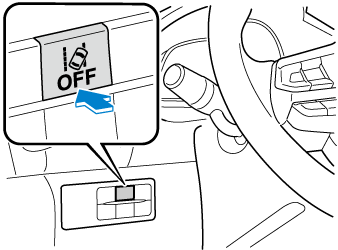When the System Operates
If the LDWS OFF indicator light in the instrument cluster turns off when the ignition is switched ON, the system goes on standby.
If the LDWS OFF indicator light in the instrument cluster turns on when the ignition is switched ON, press the LDWS OFF switch so that the system goes on standby.

Drive the vehicle in the centre of the vehicle lane while the system is on standby. The system becomes operational when all of the following conditions are met.
-
The vehicle is driven in the centre of the driving lane with the white or yellow lines on the left and right sides, or on either side.
-
The vehicle speed is about 70 km/h (44 mph) or faster.
-
The vehicle is driven on a straight road or road with gentle curves.
The LDWS does not operate in the following cases:
-
The system cannot detect white or yellow lines.
-
The vehicle speed is less than about 65 km/h (40 mph).
-
The vehicle is making a sharp turn.
-
The vehicle is making a curve at an inadequate speed.
-
The LDWS does not operate until the system detects a white or yellow line on either the left or right.
-
When the system detects a white or yellow line on one side only, the system will activate the warning only when the vehicle deviates on the side where the white or yellow line is being detected.
-
The distance and warning sensitivity (likelihood of a warning) which the system uses to determine the possibility of a lane departure can be changed.
Refer to Personalisation Features (Search).


Vehicle lane display
The vehicle lane lines (stand-by) are indicated in the multi-information display when the LDWS goes on standby.
When the LDWS detects white (yellow) lines on both the left and right sides and becomes operational, the vehicle lane lines (stand-by) are indicated in the multi-information display.

Auto cancel
In the following cases, the LDWS cancels automatically and the LDWS warning light in the instrument cluster turns on.
-
The temperature inside the camera is high or low.
-
The windscreen around the camera is foggy.
-
The windscreen around the camera is blocked by an obstruction, causing poor forward visibility.
(Vehicles with multi-information display)
The vehicle lane lines (stand-by) are indicated in the multi-information display when the LDWS is automatically cancelled.
Auto cancel warning
When the following operations are performed, the LDWS determines that the driver intends to make a lane change and the LDWS warning is cancelled automatically. The LDWS is enabled automatically after the driver performs the operation.
-
The steering wheel is operated abruptly.
-
The brake pedal is depressed abruptly.
-
The accelerator pedal is depressed abruptly.
-
The direction indicator lever is operated (after the direction indicator lever is returned, the LDWS may not operate for about 3 seconds which is the period of time required to make a lane correction).
After about 60 seconds have elapsed with the direction indicator lever left operating, the LDWS warning may operate if the vehicle is close to a white or yellow line.




 Read this first
Read this first



















